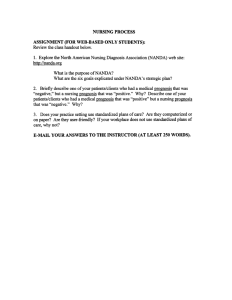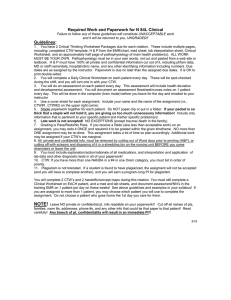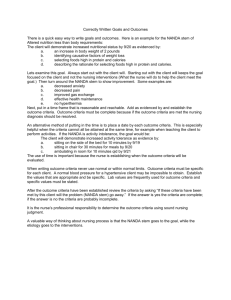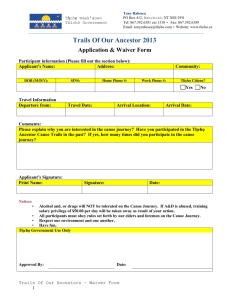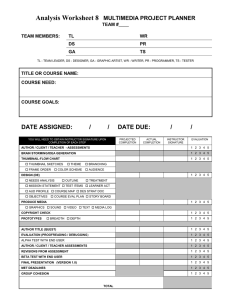Homework Tips
advertisement
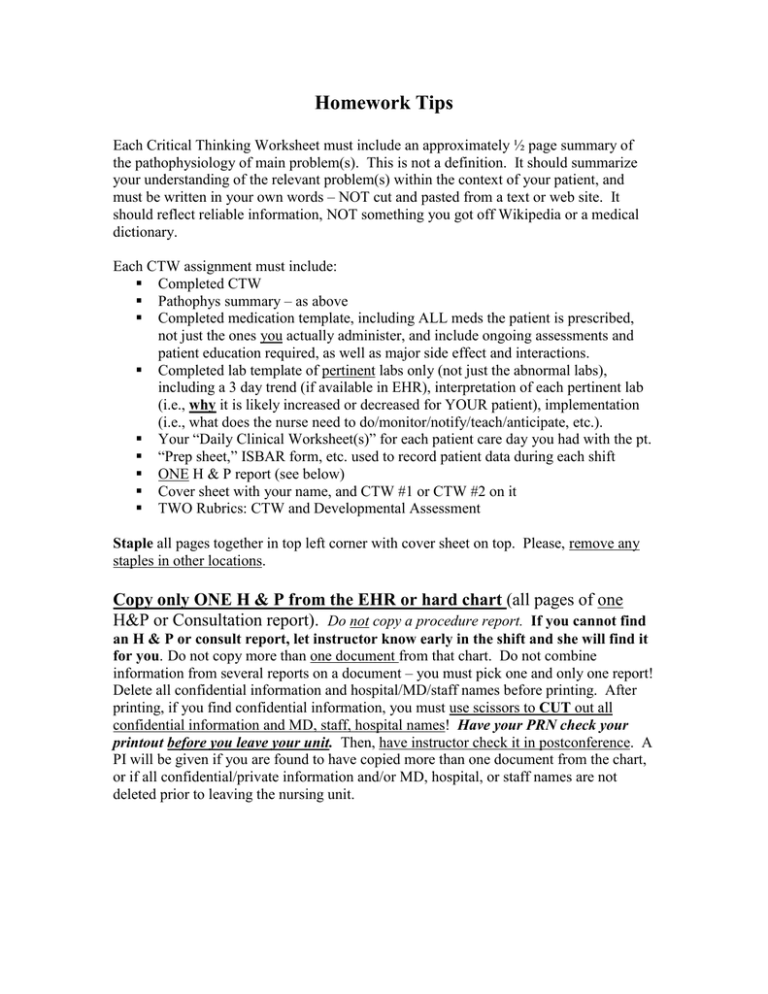
Homework Tips Each Critical Thinking Worksheet must include an approximately ½ page summary of the pathophysiology of main problem(s). This is not a definition. It should summarize your understanding of the relevant problem(s) within the context of your patient, and must be written in your own words – NOT cut and pasted from a text or web site. It should reflect reliable information, NOT something you got off Wikipedia or a medical dictionary. Each CTW assignment must include: Completed CTW Pathophys summary – as above Completed medication template, including ALL meds the patient is prescribed, not just the ones you actually administer, and include ongoing assessments and patient education required, as well as major side effect and interactions. Completed lab template of pertinent labs only (not just the abnormal labs), including a 3 day trend (if available in EHR), interpretation of each pertinent lab (i.e., why it is likely increased or decreased for YOUR patient), implementation (i.e., what does the nurse need to do/monitor/notify/teach/anticipate, etc.). Your “Daily Clinical Worksheet(s)” for each patient care day you had with the pt. “Prep sheet,” ISBAR form, etc. used to record patient data during each shift ONE H & P report (see below) Cover sheet with your name, and CTW #1 or CTW #2 on it TWO Rubrics: CTW and Developmental Assessment Staple all pages together in top left corner with cover sheet on top. Please, remove any staples in other locations. Copy only ONE H & P from the EHR or hard chart (all pages of one H&P or Consultation report). Do not copy a procedure report. If you cannot find an H & P or consult report, let instructor know early in the shift and she will find it for you. Do not copy more than one document from that chart. Do not combine information from several reports on a document – you must pick one and only one report! Delete all confidential information and hospital/MD/staff names before printing. After printing, if you find confidential information, you must use scissors to CUT out all confidential information and MD, staff, hospital names! Have your PRN check your printout before you leave your unit. Then, have instructor check it in postconference. A PI will be given if you are found to have copied more than one document from the chart, or if all confidential/private information and/or MD, hospital, or staff names are not deleted prior to leaving the nursing unit. CTW – should be completed for a geriatric patient. If there is no geriatric patient available the week before your assignment is due, consult instructor at beginning of clinical day for instructions. Failure to do this will constitute an additional CTW assignment. All sections are to be completed as applicable to your specific patient. Each section will have at minimum a #1, 3, & 5. Include a #2 & 4 if it applies to your patient (it often will!). Remember to include age-related changes as they apply, or may apply. Also remember to include diabetes in water/food, urine and kidney function in elimination, skin in hazards, Erickson’s in developmental (these are commonly omitted by students). List all data that is RELEVANT to your particular patient, basic and comprehensive. Must be individualized to the patient you are writing about. #2 Comprehensive should include relevant history, meds (in hospital AND at home), assessments, orders & interaction with other disciplines/departments, lab work, diagnostic test results, etc. It may also include age-related changes or other developmental assessment. #3 Rationales: This is application! Must express WHY you think the assessment applies to THIS PARTICULAR patient – do not tell me what the assessment itself will provide. Think, “I did _____________ because _____________________ .” (this assessment) (how it applies to my patient) Developmental data, such as age-related changes, often applies here. Also think how a health deviation might influence your decision to assess something. You need to show links between theory and application here! #4 NANDA’s should be written only if applicable and must be full, 3-part NANDA’s. Evidence to back-up your NANDA must be listed in assessment sections #1 or #2 in that category. If you write more than one NANDA in a section, list in order of priority. #5 This is your Plan of Care! Should include at minimum: At least one predicted patient outcome, i.e., “Outcome: Patient will have no further incidences of chest pain” or “Outcome: Patient will verbalize pain less than 4/10,” or “Outcome: Patient’s lungs will remain clear,” or “Outcome: Patient will have no falls during stay,” etc. “Label” your outcome by writing and underlining the word “Outome:” prior to your “patient will….” Statement. You should write at least one outcome for each NANDA in that category. Patient outcomes must be written in patient terms (not nursing goals), be realistic for your specific patient, and be measurable. At least one outcome should address your NANDA. Start your outcome with the words: “Patient will…..” and you’ll likely write it correctly. Ongoing assessments or interventions, with specific time frames, i.e., “Offer pain med every 4 hrs” or “CDB every 2 hours” or “Auscultate heart sounds every shift,” etc. You must have at least some assessments or interventions that support your outcome(s), and address your NANDA(s). Other assessments and interventions as applicable too. Collaboration with other disciplines/referrals as pertinent for your patient Note: Plagiarism is not tolerated. Instructor retains the right to require a student submit paperwork through Turnitin. 3/16
